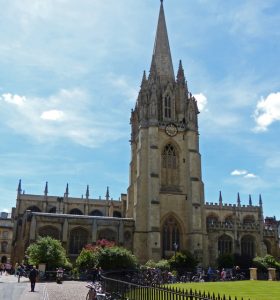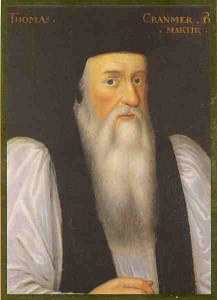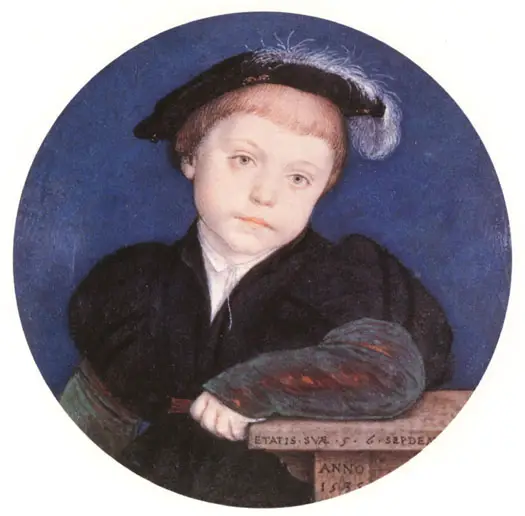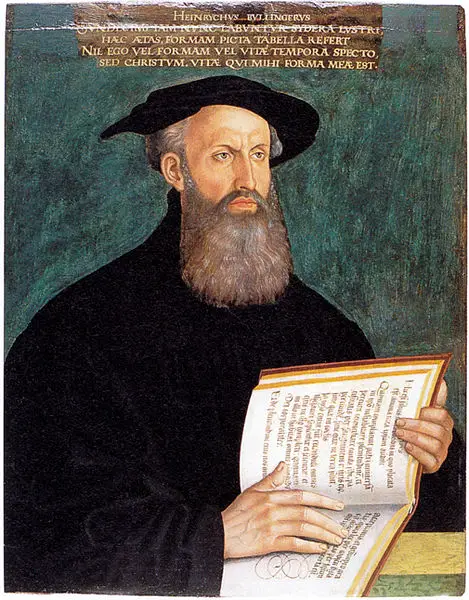 On this day in history, Thursday 12th September 1555, in the reign of the Catholic Queen Mary I, the trial of Thomas Cranmer, Archbishop of Canterbury, opened in the University Church of St Mary the Virgin at Oxford. Cranmer stood accused of heresy, being charged with two main offences, or doctrinal errors: repudiating papal authority and denying transubstantiation.
On this day in history, Thursday 12th September 1555, in the reign of the Catholic Queen Mary I, the trial of Thomas Cranmer, Archbishop of Canterbury, opened in the University Church of St Mary the Virgin at Oxford. Cranmer stood accused of heresy, being charged with two main offences, or doctrinal errors: repudiating papal authority and denying transubstantiation.
Martyrologist John Foxe gives an account of Thomas Cranmer's trial in his Book of Martyrs:
"At the coming down of the said commissioners, which was upon Thursday the 12th of September, 1555, there was erected a solemn scaffold in the east end of the church of St. Mary, over against the high altar, with cloth of state very richly and sumptuously adorned, for bishop Brooks as pope's legate, apparelled in pontificalibus, representing the pope's person. On the right hand beneath him sat Dr. Martin, and on the left hand Dr. Storey, the king and queen's commissioners, which were both doctors of the civil law; and underneath them other doctors, scribes, and pharisees also, with the pope's collector, and a rabblement of such other like.
And thus these bishops being placed in their pontificalibus, the bishop of Canterbury was sent for to come before them. He came forth of the prison to the church of St. Mary, set round with bills and glaves for fear he should start away, being clothed in a fair black gown, with his hood on both shoulders, such as doctors of divinity in the university use to wear, and in his hand a white staff. After he was come into the church, and did see them sit in their pontificalibus, he did not put off his cap to any of them, but stood still till that he was called. And anon one of the proctors for the pope, or else his doctor, called, "Thomas archbishop of Canterbury! appear here, and make answer to that shall be laid to thy charge; that is to say, for blasphemy, incontinency, and heresy; and make answer here to the bishop of Gloucester, representing the pope's person!"
Upon this, Cranmer being brought more near unto the scaffold, where the foresaid bishop sat, he first well viewed the place of judgment, and spying where the king and queen's majesties' proctors were, putting off his cap, he (first humbly bowing his knee to the ground) made reverence to the one, and after to the other. That done, beholding the bishop in the face, he put on his bonnet again; making no manner of token of obedience towards him at all: whereat the bishop, being offended, said that it might beseem him right well, weighing the authority he did represent, to do his duty unto him. Whereunto Dr. Cramner answered, that he had once taken a solemn oath, never to consent to the admitting of the bishop of Rome's authority into this realm of England again; that he had done it advisedly, and meant by God's grace to keep it; and therefore would commit nothing either by sign or token which might argue his consent to the receiving of the same; and so he desired the said bishop to judge of him. He did it, he said, not for any contempt to his person, which he could have been content to have honoured as well as any of the others, if his commission had come from as good an authority as theirs. When, after many means used, they perceived that the archbishop would not move his bonnet, the bishop of Gloucester proceeded with studied eloquence and painted art in his oration; and after he had finished, Dr. Martin took the matter in hand.
After that Dr. Martin had ended his oration, the archbishop said, "My lord, I do not acknowledge this session of yours, nor yet you, my mislawful judge; neither would I have appeared this day before you, but that I was brought hither as a prisoner. And therefore I openly here renounce you as my judge, protesting that my meaning is not to make any answer, as in a lawful judgment, (for then would I be silent,) but only for that I am bound in conscience to answer every man of that hope which I have in Jesus Christ, by the counsel of St. Peter; and lest by my silence many of those who are weak, here present, might be offended. And so I desire that my answers may be accepted as extra judicialia." When he had ended his protestation he said, " Shall I then make my answer?" To whom Dr. Martin answered, "As you think good; no man shall let you." And here the archbishop, kneeling down on both knees towards the west, said first the Lord's Prayer; then, rising up, he reciteth the articles of the creed; which done he entereth on his profession of faith.
 Toward the close of the session, Dr. Martin demanded of Dr. Cranmer, who was supreme head of the church of England? "Marry," quoth my lord of Canterbury, "Christ is head of this member, as he is of the whole body of the universal church." "Why," quoth Dr. Martin, "you made king Henry the eighth supreme head of the church." "Yea," said the archbishop, "of all the people of England, as well ecclesiastical as temporal." "And not of the church?" said Martin. "No," said he; "for Christ only is the head of his church, and of the faith and religion of the same. The king is head and governor of his people, which are the visible church." "What," quoth Martin, "you never durst tell the king so."
Toward the close of the session, Dr. Martin demanded of Dr. Cranmer, who was supreme head of the church of England? "Marry," quoth my lord of Canterbury, "Christ is head of this member, as he is of the whole body of the universal church." "Why," quoth Dr. Martin, "you made king Henry the eighth supreme head of the church." "Yea," said the archbishop, "of all the people of England, as well ecclesiastical as temporal." "And not of the church?" said Martin. "No," said he; "for Christ only is the head of his church, and of the faith and religion of the same. The king is head and governor of his people, which are the visible church." "What," quoth Martin, "you never durst tell the king so."
"Yes, that I durst," quoth he; "and in the publication of his style, wherein he was named supreme head of the church, there was never other thing meant." A number of other fond and foolish objections were made, with repetition whereof I thought not to trouble the reader.
After that they had received his answers to all their objections, they cited him to appear at Rome within fourscore days, to make there his personal answers; which he said, if the king and queen would send him, he would be content to do. And so thence he was carried to prison again, where he continually remained, notwithstanding that he was commanded to appear at Rome. Furthermore, though the said archbishop was detained in strait prison, so that he could not appear, (as was notorious both in England and also in the Romish court,) yet in the end of the said fourscore days was that worthy martyr decreed "contumax," that is, sturdily, frowardly, and wilfully absent, and in pain of the same his absence condemned and put to death."
Cranmer's fate was decided in Rome on 4th December 1555 when Pope Paul IV stripped him of his office of archbishop and gave the secular authorities permission to sentence him. Thomas Cranmer was burned at the stake in Oxford on 21st March 1556 and is known as one of the Oxford Martyrs along with Bishops Hugh Latimer and Nicholas Ridley.
Notes and Sources
Pictures: University Church of St Mary the Virgin, © Copyright Mat Fascione and licensed for reuse under this Creative Commons Licence, Geograph.org.uk; Portrait of Thomas Cranmer, Archbishop of Canterbury, by an unknown artist.
- THE LIFE, STATE, AND MARTYRDOM OF THE REVEREND PASTOR AND PRELATE, THOMAS CRANMER, ARCHBISHOP OF CANTERBURY, from Foxe's Book of Martyrs, 1889 edition.



Leave a Reply